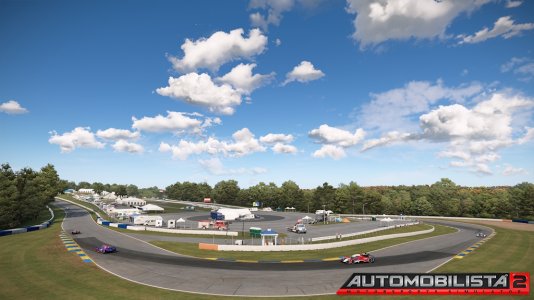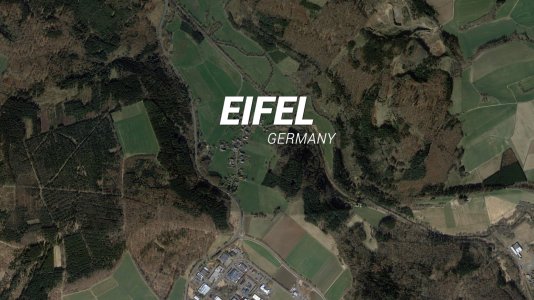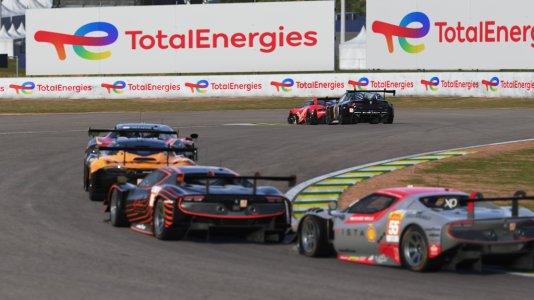Paul Jeffrey
Premium
As usual with these big iRacing updates, the main thrust of the changes are centred around the cars already released and a few core amendments to the simulation itself, plus the odd sprinkling of new content of course.
Highlights from the latest build include the new 2018 specification Chevrolet Camaro ZL1, a new circuit in the form of the dirt oval track at Kokomo Speedway and improvements to the dynamic dirt oval track behaviour.
You can check out the full (and huge) update log below:
iRacing Beta Interface
- Performance Improvements
- Dynamic Modal Menus
Modal Menus now utilize a frame that includes action buttons at the bottom, while the content of the screen can scroll freely within the frame. This means that buttons like Cancel, Join, and Test Drive will always be displayed at the bottom of the modal menu window.
- Scaling Improvements
The UI may now be scaled in 5% increments between 50% and 200%.
- Spotter Passwords
To view entries in Official Sessions, click the white icon indicating the amount of drivers registered for an event. Entries looking for a spotter are indicated by the headphone icon next to the "Register" button.
- Combined Sessions
- Test Drive
- Ultra HD Support
Downloads
- A new Content Delivery Network, Limelight, has been added as an option for our Members.
- The "Total Download Size" on the Downloads web page has been updated to reflect the amount still to be downloaded, if a previous update attempt was partially downloaded.
- Fixed an issue on the download web page which could erroneously display a "not enough free space" error message.
- Updater
Simulator
We've added some preventative measures for some issues that may have caused stuttering for some members.
Some of the third party software that the iRacing Simulator utilizes has been updated to a newer version. If you are running Windows 7, you must be running Service Pack 1 (SP1) or later in order to continue to use iRacing.
- Connectivity
The meters are now broken up into 4 separate groups: Graphics, Network, System, and Steering/Force Feedback (which is only available while driving). They are still attached to the frame rate (FPS) display, and will all be hidden if you choose to hide the FPS display.
Each individual group can be disabled, shown graphically, or shown numerically, via selections in the lower-right area of the in-Sim Options Menu in the "On Screen Displays" section.
- Graphics Group:
Numerically, this value is displayed in milliseconds, and only the 1-second running average is displayed.
Graphics (G) Graphically, this meter shows a 1-second running average of how much time it is taking your graphics card to draw the displayed frames. An empty bar means it is taking 0 seconds, and full bar means it is taking 1 second. Like the C and R meters, a purple bar is shown beneath this one, and shows the 15-second running average.
Numerically, this value is displayed in milliseconds, and only the 1-second running average is displayed.
- Network Group:
Graphically, an empty bar is 0ms of round-trip network latency between your computer and the race server, while a full bar is 1000ms (one second) of round-trip latency.
Numerically, this measurement is in Milliseconds.
Quality (Q)
Graphically, the left-side meter measures the incoming network packet loss to the Simulation from the race server, and the right-side meter measures the incoming packet loss on the race server from your Simulation. Both meters measure only your connection to the race server, not your own, nor our race server’s overall internet connection packet loss. An empty meter is 0% packet loss, and a full meter is 50% packet loss.
Numerically, this measurement is a percentage (100 means no packet loss, 0 means 100% packet loss).
- System Group:
Graphically, this meter shows a 1-second-long running average of the percentage of that 1/60th of a second the simulation is taking to “run the world”. An empty bar means 0% of that 1/60th of a second is being used, while a full bar means at least 100% is being used, but it could actually be “running long”. If the simulation keeps “running long”, it will begin to fall behind “real time”, leading to time Skew between your Simulation and the server. A purple bar is drawn beneath the normal CPU bar, and it shows a longer-term 15-second running average.
Numerically, this measurement is a percentage of the allowed 1/60th of a second that the Simulation is using to update the world. Only the 1-second running average is displayed
Skew (S) This meter measures the simulation-world time difference between your Simulation and the correct simulated-world time, as kept by the race server. While small flickers of Skew can appear due to “network jitter” (variations in the round-trip network Latency between your computer and the race server), significant amounts of Skew are almost always caused by your computer being unable to perform the calculations necessary to keep up with real time (see the CPU (C) meter discussion above). That is why this metric appears as part of the System group, instead of the Network meter group.
Graphically, an empty bar means your simulation is in sync with the server. As the meter grows to the left from the center, your system is falling behind the server, and the bar will be full-left when the Sim is 1 second behind. As the meter grows to the right from the center, your system is getting ahead of the server, and the bar will be full-right when it is 1 second ahead.
Numerically, this measurement is in seconds.
- Paging (P) Modern computers have physical RAM (memory), but programs that run on them operate using a “virtual memory” address space. For a program to actually use the contents of a piece of its virtual memory, it must have actual physical RAM memory attached to it. Paging is the term that covers how the operating system manages the attachment of physical RAM memory to a program’s virtual memory addresses. When the OS must intervene in the virtual<->physical memory attachment of a 4K byte “page” of memory, that causes a “page fault”. “Hard” page faults are when the operating system must transfer data between physical RAM and your disk (or SSD). These are slow operations that can greatly impact the performance of your computer if they occur at a high rate.
Numerically, this measurement displays the number of hard page faults per second.
- Steering Group:
Graphically, red indicates you have 100% torque saturation, yellow indicates you have 85% to 99% torque saturation, and green indicates 84% or less torque saturation.
Numerically, the value displayed is the percentage of torque saturation.
If the Simulation determines that it seems to be having performance issues that are causing it to fall behind the race server, the FPS and other meter displays will be forced on, even if you currently have them hidden. Additionally, the System meters (C/S/P) will be forced to be displayed, even if you had marked that particular meter group as hidden. The labels of the meters that indicate the indicate the performance issue will be flashed. Currently only the C and S meters are analyzed for performance issues, and so only those meter’s labels will be flashed.
- Driving Aids
Hybrid Power Units
Removed an efficiency correction that was left in by mistake in the MGU-K deploy demand, and deploy cap calculations.
- Dirt
Made the toughness of dirt and resulting grip more sensitive to water content.
The lateral strength effect of the cushion dirt has been reduced slightly.
Heat Races at Dirt Ovals will now initialize with more track wear, and the variance of that starting usage percentage has been increased.
The track groove that forms during Dirt Oval races should now be displayed even with the Graphics Option "Render Dynamic Track Data" disabled.
- Rallycross
Opponent Cars
- Opponent vehicles on your machine should now have more accurate positioning measurements sent to it from the Race Server, including altitude, roll, pitch, and steering angle. This should make opponent vehicles appear to drive smoother while racing, and in Replays.
- Fixed an issue where some values were incorrectly flashing yellow.
- Improved the dynamic level-of-detail (LOD) adjustment for cars and pit objects when too many are visible and too high LODs are being used all at once. The LODs are now based on actual object distance rather than view depth.
- Fixed an issue where the driver's hands would disappear from your car when you were not the active driver.
- Smoke effects now react to wind, lighting, shadow, and a visual turbulence effect has been added.
- Jet fly-overs have been adjusted.
- Backfires and gear shifting sounds for stockcars have been improved.
- Marble impacts, scrubs, and castoff sounds have been improved.
- Hit and scrape sounds for grounding impacts of vehicle undertrays on soft materials, such as tirewalls, rubber, and some chicane humps have been improved.
- Sawtooth curb sounds have been improved.
- Audio volumes have been re-balanced for all default iRacing camera sets.
- The Craftsman logo has been added to the Paint Kit.
- The Simulation will no longer attempt to dampen when the Force Feedback option "Dampen Oscillations" is checked. Instead, it will only reduce the force level. The dampen effect is not stable on all wheels. This should help reduce some wheel oscillations when the car is parked.
- New driver change telemetry variables have been added:
- dcDashPage, dcPitSpeedLimiterToggle, dcDRSToggle, dcPushToPass, dcStarter, dcLowFuelAccept, dcHystBoostHold, dcFCYToggle
- New driver pit telemetry variables have been added:
- dpFastRepair, dpFFlapSetting, dpFuelAddKg, dpFuelFill, dpFWingAngleOffset, dpFWingSetting, dpLFTireChange, dpLFTireColdPress, dpLRTireChange, dpLRTireColdPress, dpLTireChange, dpRFTireChange, dpRFTireColdPress, dpRRTireChange, dpRRTireColdPress, dpRTireChange, dpRWingAngleOffset, dpWinshieldTearoff, dpFUFangleIndex
- Driver pit telemetry variables "dpLrWedgeAdj" and "dpRrWedgeAdj" have been renamed to "dpLRWdgeAdj" and "dpRRWedgeAdj" to better match the rest of the driver pit telemetry variables.
- The latest EAC SDK has been applied.
Audi R18
- The "Hybrid" screen display has been updated to show battery state of charge and % deployment used each lap.
- 2018 Season 4 BoP Adjustment: Vehicle weight has been increased by 35kg.
- Improved vehicle sounds including: gear shift, engine, transmission, pneumatic compressor, and backfires.
- Hood and front fenders can now be removed in collisions.
- Baseline setup has been updated.
- Season setups have been updated.
- Improved curb sound levels for this open-top vehicle.
- Improved curb sound levels for this open-top vehicle.
- Season setups have been updated.
- (ALL) - An option to adjust the LR droop chain has been added in the garage.
- (ALL) - Brake Bias adjustment range has been opened to allow from 10% (full rear brake) to 90% (full front brake).
- (ALL) - Maximum brake pedal force input has been increased. You should find braking performance to be greatly improved.
- Fixed fuel restrictions have been removed.
- Adjustments have been made to the Mass/Inertia properties.
- Tire tread pattern has been adjusted.
- Season setups have been updated.
- (ALL) - Setups may now be shared across all three Dirt Sprint Car models (305, 360, and 410).
- (ALL) - Fixed fuel restrictions have been removed.
- (ALL) - Adjustments have been made to the Mass/Inertia properties.
- (ALL) - Aerodynamic performance has been adjusted.
- (ALL) - Shock damping characteristics have been updated.
- (ALL) - Tire tread pattern has been adjusted.
- (ALL) - Opponent cars should race more true to their human driver on your local machine.
- (ALL) - Season setups have been updated.
- (ALL) - Setups may now be shared across both Dirt Non-Winged Sprint Car models (360 and 410).
- (ALL) - Fixed fuel restrictions have been removed.
- (ALL) - Shock damping characteristics have been updated.
- (ALL) - Tire tread pattern has been adjusted.
- (ALL) - Season setups have been updated.
- Fixed an issue where car parts were not correctly being removed from opponent vehicles when taking damage.
- 2018 Season 4 GTE BoP Adjustment: Aero downforce has been increased slightly. Fuel fill rate has been updated to equalize fuel fill times during pit stops.
- Gear ratios have been modified to include the real-world homologated gear ratio stacks: FIA, IMSA Daytona, and IMSA Short.
- The Ferrari Challenge gear ratio stack has been added.
- Please note: 1st gear from the real car was not modeled. As such, 1st through 6th in iRacing are equivalent to 2nd through 7th in the real car.
- Reduced shock pin range to eliminate the ability to utilize in a hyper-extended state.
- New backfire sounds have been added.
- Slightly increased the probability of off-throttle backfires occurring.
- Fixed an issue where the current gear selection was not showing up in opponent cars during replays.
- 2018 Season 4 GTE BoP Adjustments: Engine power has been increased slightly for better acceleration. Slightly reduced aero drag at low rear wing angles. Fuel fill rate has been updated to equalize fuel fill times during pit stops.
- Adjusted sounds for backfires and pneumatic shifting.
- Minor improvements to the engine, tire, and wind buffeting sounds.
- New backfire sounds have been added.
- Reduced shock pin range to eliminate the ability to utilize in a hyper-extended state.
- New backfire sounds have been added.
- Minor improvements to the engine, gear shifts, brakes, tires and backfire sounds.
- Fixed a minor texture issue with one of this vehicle's paint patterns.
- This car has been renamed from "Indycar Dallara circa 2011" to "Indycar Dallara - 2011".
- Improved curb sound levels for this open-top vehicle.
- Engine and tire sounds have been updated.
- Cold and warm engine idle RPM values have been adjusted slightly.
- Improved engine, tire, and wind buffeting sounds.
- On-board engine idle sounds have been updated.
- This car has been renamed from "Mazda MX-5 Cup circa 2015" to "Mazda MX-5 Cup - 2015".
- Fuel pressure display will now correctly use the Metric system.
- This car has been renamed from "Mazda MX-5 Roadster circa 2015" to "Mazda MX-5 Roadster - 2015".
- Fuel pressure display will now correctly use the Metric system.
- The Push-to-Pass control has been replaced with Deployment Hold.
- This should give drivers greater flexibility to fine tune deployment without taking the hit P2P places on MGU-H harvesting. Please also note that P2P functionality remains available via Qualifying mode.
- The in-car brake bias is now adjustable with the fixed setup for this car.
- Improved curb sound levels for this open-top vehicle.
- Season setups have been updated.
- Improved engine, gear shift, compressor, and backfire sounds.
- Fixed an issue where the nerf bars were not changing color correctly when viewed from the cockpit camera.
- Season setups have been updated.
- An additional gear selection has been added.
- Grip at super short tracks (Martinsville and smaller) has been increased.
- Aero drag has been reduced slightly.
- Engine cooling at higher tape levels has been increased.
- Staggers have been updated for different tracks.
- The camber limit has been reduced to 6 degrees in the front.
- Maximum allowable height has been set to 6" in the front, and 8" in the rear, per NASCAR's inspection process.
- The left-front ride height may no longer be set higher than right-front ride height.
- Front toe adjustment range has been reduced to +/- 1/4”.
- Improved engine, gear shift, and backfire sounds.
- Fixed an issue where this vehicle had too much front rebound damping, sometimes causing a randomly occurring speed increase.
- Season setups have been updated.
- An additional gear selection has been added.
- Grip at super short tracks (Martinsville and smaller) has been increased.
- Aero drag has been reduced slightly.
- Engine cooling at higher tape levels has been increased.
- Staggers have been updated for different tracks.
- The camber limit has been reduced to 6 degrees in the front.
- Maximum allowable height has been set to 6" in the front, and 8" in the rear, per NASCAR's inspection process.
- The left-front ride height may no longer be set higher than right-front ride height.
- Front toe adjustment range has been reduced to +/- 1/4”.
- Improved engine, gear shift, and backfire sounds.
- Fixed an issue where this vehicle had too much front rebound damping, sometimes causing a randomly occurring speed increase.
- Season setups have been updated.
- Grip has been increased slightly at super short ovals and road tracks.
- Staggers have been updated for different tracks.
- Gears have been adjusted at Pocono Raceway.
- Front toe adjustment range has been reduced to +/- 1/4”.
- Improved engine sounds.
- Season setups have been updated.
Last edited:










